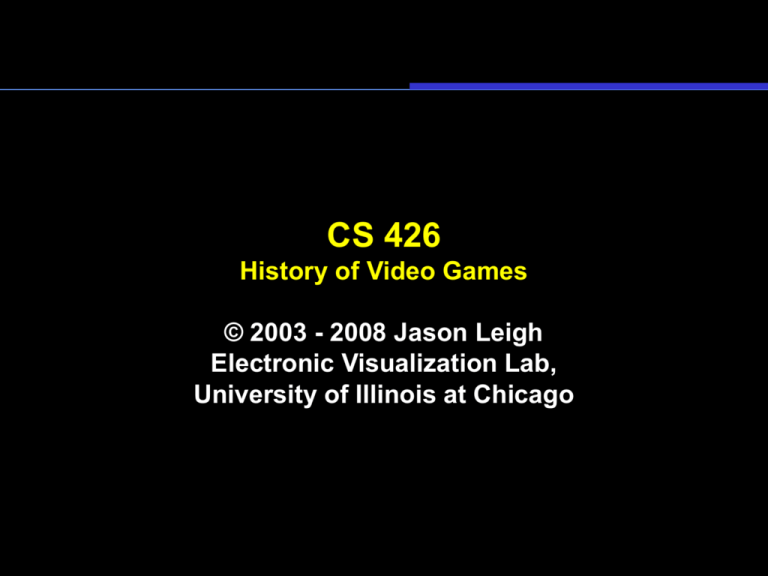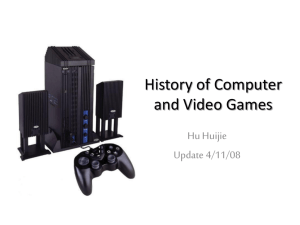CS 426 : Multimedia - Electronic Visualization Laboratory
advertisement

CS 426 History of Video Games © 2003 - 2008 Jason Leigh Electronic Visualization Lab, University of Illinois at Chicago 1889-1954 • 1889 - Fusajiro Yamauchi establishes the Marufuku Company to manufacture and distribute Hanafuda (flower cards), Japanese playing cards. 1951 – Changes name to The Nintendo Playing Card Company. "Nintendo" means "leave luck to heaven." • 1947 - Akio Morita and Masaru Ibuka establish Tokyo Telecommunications Engineering Company. Licensed transistor from Bell Labs in 1952. The transistor radio is a success in Japan, and Ibuka and Morita begin looking at marketing their products in the United States and Europe. Sony was born (from Latin word sonus (sound)). • 1954 - Former US Korean War veteran David Rosen starts Service Games to export coin-op machines to Japan. In the 1960s, Rosen made his own coin-operated games, so he purchases a Tokyo jukebox and slot-machine company. The name SEGA, short for "SErvice GAmes," is stamped on the games . 1951-1961 • • • • • 1951 - Ralph Baer, an engineer with Loral, company that develops and manufactures complex military airborne electronics, is instructed to "build the best TV set in the world." Baer suggests they add some kind of interactive game to the TV set to distinguish it from other companies' TVs, but management ignores the idea. 1958 - Brookhaven National Lab physicist Willy Higinbotham invents interactive table-tennislike game on an oscilloscope to keep visitors from getting bored. Believing that he hasn't invented anything, Higinbotham doesn't patent the device. YouTube Video of table tennis 1961 - Spacewar. MIT student Steve Russell creates Spacewar, the first interactive computer game, on a Digital PDP-1 Spacewar used new teletype terminals with CRT screens to display the graphics. Program is 9K bytes. YouTube Video of Spacewar 1962-1970 • • • • • • • 1962 - Nolan Bushnell enrolls in engineering school at the University of Utah, where he is first exposed to Russell's Spacewar. 1965 - Nolan Bushnell gets a summer job at a Salt Lake City carnival, where he is in charge of the arcade. Bushnell envisions an arcade filled with computer games but realizes it's only a dream, since computers are much too expensive to make the idea feasible. 1966 - Ralph Baer rekindles his idea for a secondary use for television sets. He begins researching interactive television games. The defense contractor he works for, Sanders Associates, is interested and gives him the latitude needed to develop it. 1967 - Baer and his team succeed in creating an interactive game that can be played on a television screen. They develop a chase game and follow it up with a video tennis game. They also modify a toy gun so it can distinguish spots of light on the screen. 1970 - Magnavox licenses Baer's TV game from Sanders Associates. Bushnell builds an arcade version of Spacewar. Bushnell calls his game Computer Space. Arcade-game manufacturer Nutting Associates purchases Computer Space and hires Bushnell to oversee the building of it. 1971-1972 • 1971 - Nutting Releases First Arcade Video Game- Computer Space but public finds it too difficult to play. • 1972 - Magnavox begins manufacturing the Odyssey, Baer's TV game system. • Computer Space does not sell well, and Bushnell comes to the conclusion that it is too difficult to play. He realizes that if he can design a simple game, it might be a major draw. He informs Nutting, who tells him to go ahead and design a new machine. Bushnell decides that since he is the brains behind video games he should get a larger share of the profits. When he demands a third of Nutting Associates and doesn't get it, he leaves the company. 1972 • • • • Bushnell Starts Atari, a term from the Japanese game Go, whose meaning is equivalent to "check" in chess. Pong Is Born - Bushnell hires Al Alcorn to program games. Since Alcorn is inexperienced, Bushnell has him program a simple video tennis game as an exercise. They call the game Pong, for two reasons: first, "pong" is the sound the game makes when the ball hits a paddle or the side of the screen, and second, the name Ping-Pong is already copyrighted. Bushnell tries selling Pong to established arcade manufacturers. After finding Bally disinterested, Bushnell decides to market the game himself. Pong is test-marketed in Andy Capps, a local bar. Within two weeks the test unit breaks down because the coin drop is flooded with quarters. Pong is a success. Magnavox Releases Odyssey. Many people buy it because it is the closest thing they can get to a home version of Pong. Video Segments • Nolan Bushnell Interview on Atari Anniversary PSX disk: – – – – – – [show “Beginning of Atari”] http://youtube.com/watch?v=znP8zMCDzxc [show “Conception and history of pong”] http://youtube.com/watch?v=B7DuUZokcw0 [show “Founding of an industry”] http://youtube.com/watch?v=12m4OONd_Qo 1976 • Fairchild Camera & Instrument releases its Video Entertainment System (later renamed Channel F), the first programmable home game console. Cartridges are born. • Exidy Games releases Death Race 2000, a driving game based on a 1975 movie of the same name. Public outcry against video game violence gains national attention, and the game is taken off the market. • Breakout, Atari Inc., 1976. Designed by Atari's 40th employee Steve Jobs, aided by videogame enthusiast Steve Wozniak. The two later went on to found Apple Computer, using parts "borrowed" from Atari to build their first prototype. Side note… • • • • • EC Comics (Entertaining Comics) published late 1940s-1956 Until Comics Code Authority whitewashed all comics to remove themes of horror & violence. Psychiatrist Fredric Wertham and Senator Estes Kefauver's Committee on Juvenile Delinquency attacked horror comics as causes of the rise in juvenile delinquency and crimes by minors. These comic books were accused of having no redeeming value to society and were effectively banned by the actions of these groups in creating the Comics Code. EC Comics were superior to other comics of the 1950s because of a higher quality of writing and artwork, and they were widely imitated by other comics publishers. The subject matter for EC Comics were horror, science fiction/fantasy, crime stories, war stories and stories with a social message that generally had a twist or "shock" ending. There were also studies of the effect of television and radio on juvenile delinquency in the early 50s. Video Segment • Nolan Bushnell Interview on Atari Anniversary PSX disk: – [Show “CPU used in Pong”] – http://youtube.com/watch?v=vOAelPA_OTE 1977 • Atari Is Sold for $28 Million Nolan Bushnell sells Atari to Warner Communications for $28 million. Bushnell remains with Atari as chairman of the board. • 1977 Atari releases its first programmable (cartridge-based) game system, the Video Computer System (VCS--later known as the Atari 2600), in time for Christmas, for $249. • Bally releases a programmable console called the Bally Professional Arcade. With a retail price of $350, the system fails to catch on. 1978 • Atari releases the arcade game Football. The game features a revolutionary new controller called the trackball. • Midway imports Space Invaders from Taito. Space Invaders gives you a goal by displaying the current high score for you to beat. • Atari begins selling its line of 400 and 800 computers to compete against Apple. The public, however, associates Atari with games, and the computers are never taken seriously. Atari 400/800 – the 1st Personal Computer with a Graphics Processor • • • • • No support for polygons whatsoever. Polygons didn’t show up till 1994 even though there were $10000-$500000 workstations available that could do this by late 80s. Programmed entirely in Assembly Language (translates to Machine code) 6502 Motorola Processor – 1 MHz Has it’s own graphics processors (ANTIC and GTIA). Player/Missile Graphics (Sprites): – – – – • • • • • • Sprites are graphical elements independent of main graphics memory. Used to implement, game characters and missiles. 4, 1 color (8 pixel wide sprite as 1 long vertical strip) 4, 1 color (2 pixel wide sprite as 1 long vertical strip) Moving sprites horizontally is 1 register call. Moving it vertically requires clearing sprite and copying it. Character-set graphics – programmable character-set pixels. Used mainly for creating scrolling backdrops. Memory-mapped graphics – graphics system can point to any address location and use it as graphics memory. Mainly for side-scrolling games. Vertical Blank Interrupts – Use vertical retrace of raster to do graphics updates (sprite movement, and side-scrolling) so that graphics does not flicker. (equivalent to double-buffering in modern graphics systems and “threading”.) Only have a few milliseconds to do your computation. Display List Interrupts – Modify screen data as the raster scans across the screen. This is the only way to get multi-color sprites. 4 voice sound. http://www.atariarchives.org Atari Graphics Modes ANALOG Computing (1984) http://www.cyberroach.com/analog/an19/our_game.htm Jason Leigh, of Kowloon, Hong Kong, sent me a letter (by air mail) with the most gorgeous stamp I've received since Our Game began. It's a 30-cent stamp called "Hong Kong by Night." Jason's game idea isn't bad either. He writes: "Why always be the good guys? You could have a game where you hold up a bank. The first level begins as you have to plant sticks of dynamite on the vault, while shooting bank tellers trying to get to the alarm bell. Every time you shoot a teller, he returns to his counter and his sequence of migrations to the bell re-starts. When you've attached enough dynamite to the vault, it blows up and you can rush inside to grab a bar of gold. You can carry one bar at a time and you must carry it back to your get-away car each time. When you have your hands full you cannot shoot, so there is a danger of the bank teller's reaching the alarm bell. When your attempt is successful, your computer figure grins happily out of the screen and you begin robbing the next bank until you're eventually caught." Sounds like you've got the makings of a coin-op game hit, Jason: action, violence, skill, and suspense (when the alarm bell goes off, it's risky to stay because the police will show up; on the other hand, there's more gold to be had in the vault 1979 • Atari releases Lunar Lander, its first vector graphics game. • YouTube Lunar Lander • Despite Lunar Lander's popularity, Atari halts production of the game and begins releasing Asteroids in the Lunar Lander cabinets. Asteroids introduces a new feature to arcades: High scorers can enter their three-character initials at the end of the game. 1980 • • • • • Several VCS programmers leave Atari in a dispute over game credits and form Activision, the first "third -party developer" and now a rival VCS software house. While Atari doesn't give individual programmers credit for their work, Activision recognizes individual game developers by including their names on the game packaging and in the marketing efforts. Atari coin-op designer Ed Rottberg creates Battlezone, the first three-dimensional firstperson game. The US government later commissions an enhanced version of Battlezone for military training purposes. YouTube Battlezone YouTube of Encounter Namco releases Pac-Man, the most popular arcade game of all time. Originally named Puck Man, the game is renamed after executives see the potential for vandals to scratch out part of the letter P on the game's marquee, which might discourage parents from letting their children play. Pac-Man becomes the first video game to be popular with both males and females. 1980 • Williams, a Chicago-based manufacturer of pinball machines, releases Defender, its first video game. Designed by Eugene Jarvis, Defender is a side-scrolling shooter that features the industry's first virtual world. Because the monitor can only display a portion of the action, a "radar" at the top of the screen shows the overall picture of events that are occurring outside the boundaries of the screen. Defender becomes an immediate hit. • YouTube of Defender 1981 • Nintendo artist Shigeru Miyamoto creates Donkey Kong. The hero, originally called Jumpman, is a squat carpenter racing to save his girlfriend Pauline from a crazed monkey. Jumpman is later named Mario by Nintendo of America's staff, in honor of his resemblance to their landlord Mario Segali. • Atari releases Tempest, a colorvector arcade game based on still-unstable graphics technology that is prone to early failure. The machine attracts crowds of devoted players. • A man dies of a heart attack while playing Berserk--video gaming's only known fatality. 1982 • General Consumer Electronics (GCE) releases the Vectrex, the first and only home console based on vector graphics technology. The Vectrex includes a built-in game (Minesweeper, an impressive Asteroids clone) and one fourbutton analog joystick controller. • On December 7 (3:04pm Eastern Standard Time), Atari announces that VCS sales did not meet predictions. Warner Communications stock drops 32 percent in a single day. • Youtube Video 1982 • TRON – the film is released. • First time a film had created a story about the inside of a computer, which spawned many arcade games. • YouTube TRON • YouTube TRON arcade 1983 • Cinematronics releases Rick Dyer's Dragon's Lair (animated by Don Bluth), the first arcade game to feature laserdisc technology. • YouTube Dragon’s Lair • Commodore releases the Commodore 64, an inexpensive but powerful computer that outperforms any video game console. • With too many products on the shelves from a multitude of publishers, many third-party companies go out of business. The games from these companies are then discounted heavily. Companies that are still in business cannot compete against the cheap games, so they wind up losing money because of unsold inventory. 1984 • Milton Bradley begins distributing the Vectrex. The company quickly lowers the price to make it competitive with the consoles. The price is eventually dropped to $100, forcing Milton Bradley to lose money with each until sold. Milton Bradley finally cancels the Vectrex. Vectrex 3D imager (uses CDROM drive to shutter glasses in synch with Vectrex screen) 1985 • Nintendo test-markets its Nintendo Entertainment System (NES) in New York. Retailers are so skeptical about video games that Nintendo has to agree to buy back all unpurchased inventory. Armed with a large number of Nintendo-developed original titles and arcade games, the NES is a hit in a limited market release. • Russian programmer Alex Pajitnov designs Tetris, a simple but addicting puzzle game that can be played on PCs. 1989 • Nintendo releases its handheld Game Boy ($109). The system comes with Tetris, and despite a tiny monochrome screen, it begins to build a historic sales record. A Game Boy version of Super Mario (Super Mario Land), a Breakout clone (Alleyway), and a baseball game are quickly released. • Sega releases the 16-bit Genesis in the United States after limited success in Japan.$249 1991 • • • • Nintendo releases the Super Famicom in America and calls the $249 console the Super NES (SNES). Journalists begin to wonder aloud whether Mario will be enough to convince NES-dedicated parents to make the investment in a new machine. Sega unveils Sonic the Hedgehog, which it hopes is a force that will one day conquer the NES and SNES. Charmed by the character, critics are quick to support it but call the choice between Mario and Sonic a toss-up. Most pick Super Mario World as the better of the two. Time Traveler, Sega, 1991. Time Traveler was the first of two "Hologram" games that Sega produced. The game characters appeared to be holographically projected onto the playing area. Time Traveler contained a laser disc player and a T.V. monitor that was aimed into a curved mirror. The 2-D image was reflected through the surface glass and produced an illusion of depth. The images seemed to have dimension, but the game didn't truly produce holograms. YouTube Time Traveler 1993 • Incensed by the violence in Mortal Kombat and Night Trap, Senators Joseph Lieberman (Connecticut) and Herbert Kohl (Wisconsin) launch a Senate "investigation" into video game violence, threaten to somehow effect a ban on "violent" games, and eventually soften their demands and concede to an industry-wide rating system. 1994 • The Sega Saturn and Sony PlayStation are launched in Japan. By year's end, critics are pointing to the PlayStation as the superior machine. 1994 The Entertainment Software Rating Board (ESRB) is established to rate video games. Large letter icons appear on game boxes to let consumers know the recommended age of players for each game and whether the game is violent or risqué. 1995 • Nintendo releases the Virtual Boy ($179). • YouTube Virtual Boy • Sony releases the PlayStation in the United States for $299, $100 less than expected. Sales are strong, and a collection of good release titles receives praise from the media and consumers. • The launch of the N64 in Japan supposedly nearly causes riots, but because of a muchimproved system of distribution, people are able to buy N64 machines through local convenience stores without problems. Nintendo enjoys record sales and quickly sells out of its initial stock of hardware, but after a few weeks, N64 sales practically stop due to lack of software. Starved as they might be for software, people refuse to purchase the third Nintendo 64 launch title, Saikyo Habu Shogi, because it's not appealing enough. The rumors of too little software in development proved correct, and new releases are very few and far between for several months. 1995 • Mortal Kombat- the film is released. • First time an arcade game had created a film. 1996 • The N64 is released in United States. More than 1.7 million units are sold in three months, and once-doubtful third-party developers rush to embrace the cartridge medium they had previously questioned, if only to cash in on the immense media popularity of the new machine. • Sony sales are said to top $12 million per day through the Christmas shopping season, and the PlayStation holds on to its worldwide place as the number-one next-generation game console. The video game industry has a highly profitable year, and software prices on 32-bit games begin to show exceptional volatility. 1997 • The PlayStation Is the Most Popular Gaming Console Sony releases figures in April that prove the PlayStation is the most popular gaming system in the world. The figures show that 5 million units have been sold in Japan, 4 million in the United States, and 2.2 million in Europe. These numbers nearly double four months later, when the 20 millionth unit is sold. Analysts believe the PlayStation's popularity will carry it through 1998. • In November 1996, Bandai released the Tamagotchi in Japan. Quickly became a national obsession in Japan, selling for hundreds of dollars, well above its original $16 price tag. • October 4, 1997, Gumpei Yokoi, the inventor of the Game Boy, was involved in a car accident. When the 56-year-old Yokoi stepped out of his car to inspect the damage, he was hit by another car and was killed. Although the Game Boy was Yokoi's most successful product, he was also responsible for the Virtual Boy, and the cross-key directional pad that eventually replaced the joystick as the controller of choice. 1998 • The IDSA (Interactive Digital Software Association) announces that 1998 was a banner year for the electronic entertainment industry. During the first six months of 1998, sales were up 30 percent from all of 1997, which itself had been a record year. • Unfortunately, the news isn't all rosy. The IDSA also reports that the home video game industry is flourishing at the expense of the arcade industry. 1999 • On September 10, Sega of America reports earnings of $98 million within the first 24 hours of launching the Dreamcast in the United States. 2000 • Sony launches the PlayStation 2 in Japan on March 4. In two days, the company sells 1 million consoles--a new record. As is the case with all Japanese launches, gamers begin lining up outside stores two days in advance. Unfortunately, demand exceeds supply and not everybody gets a console, including those who preordered. Robberies of PlayStation 2s are reported. • Lines begin forming outside of Sony's Metreon store in San Francisco roughly 28 hours before the PlayStation is set to go on sale in the United States on October 26. Eventually, more than 1,000 people line up. Nearly half of them go home empty-handed. 2001 • • • • • On January 31, Sega of America finally announces a major restructuring--an announcement that has been expected for several weeks. The price of Sega's own Dreamcast will drop to $99.95 beginning on February 4, and production of new Dreamcasts will cease on March 31. At that time, the company will exit from the hardware business and become a software developer, specifically in the area of online gaming. Sega of Japan follows suit two days later and announces that the price of the Japanese Dreamcast will be reduced on March 1. A year after the PS2's March 2000 launch in Japan, Sony has sold 10 million units of the console worldwide, a feat accomplished more than three times faster than the original PlayStation. A fixture in the arcade industry since 1973, Midway Games announces in June that it is leaving the coin-op market to focus solely on console development. The company had already trimmed approximately 60 employees from its coinop division in March. The results of an Interactive Digital Software Association survey reveal that the average family spends 10 to 11 hours per week playing console or computer games, with 34 percent of respondents calling games "the most fun entertainment activity," as compared with 16 percent for television. Following in the footsteps of the US Army's use of Battlezone in the early '80s, the US Department of Defense licenses the Rainbow Six: Rogue Spear game engine for tactical training exercises. 2001 • 9/11 happens • Changes are made to Flight Simulator 2002 to remove the World Trade Center towers from the flying environment and a patch is released to remove them from Flight Simulator 2000. • On November 15, at an event in Times Square's Toys "R" Us, Microsoft officially launches the Xbox. Based on PC architecture, the $299 console comes equipped with a 733Mhz CPU, Nvidia GPU, 10GB hard drive, and built-in Ethernet port. In less than a month, Microsoft ships 1.1 million units to retailers. The system's best-selling launch title is Halo. • Nintendo's GameCube is released in Japan on September 13 and North America on November 18. The diminutive cube-shaped console uses propriety discs based on DVD technology and is priced at $199, $100 less than the Xbox and PS2. Nintendo reports that $98 million worth of systems, games, and accessories were sold on the US launch day, with more than 500,000 systems sold in the first week. Luigi's Mansion is the best-selling launch title for the console. 2005 • Xbox 360 - Release Nov 2005 • PS3 - Original intended release Spring 2006- delayed to Nov 2006 • Nintendo Wii - Planned release Nov 2006 Survey of Game System Specs Year 1972 1976 1977 1977 Manufacturer Magnavox Fairchild Atari Bally 1978 Magnavox Brand Name Odyssey Channel F 2600 Professional Arcade Odyssey 2 Processor RAM Price $249 $350 64 bytes 16 color palette, 4 max on-screen; 1 color per sprite; 8x8 sprite size; 12 max sprites on screen Intel 8048 (8-bit) 1.78MHz 1979 1983 1983 1985 1986 1986 1989 1989 1990 1991 Mattel Coleco Atari Nintendo Sega Atari NEC Sega SNK Nintendo Intellivision Colecovision 5200 NES Master System 7800 Turbografx 16 Genesis Neo Geo SNES 1993 1995 1995 1995 1996 Atari Sega Nintendo Sony Nintendo Jaguar Saturn Virtual Boy Playstation N64 $299 Z-80A (8-bit); 3.58 MHz Motorolla 6502c (8-bit) 1.78 MHz 8K 16K 16 colors; 32 sprites 256 colors, 16 on-screen Click here! Motorolla 68000; 7.67 MHz 64K $249 128K $399 $179 21-bit color; realistic texture mapping (mipmap; perspective correction; environment mapping) MIPS R4000 series 64-bit CPU; 93.75MHz Sega Sony Microsoft Dreamcast PS2 Xbox Nintendo GameCube 64 colors on screen; 512 color palette. 256 colors simultaneously; 32678 color palette;128 max sprites per screen; 32 max sprites per line; 64x64 max sprite size 16-bit CPU; 3.58 MHz 1999 2000 Fall 2001 Fall 2001 Graphics $299 64M 700Mhz Pentium III Custom IBM PowerPC "Gekko" (32- 40M bit int, 64-bit fp); 485MHz $299 $199 Nvidia GeForce 3 Custom ATI/Nintendo "Flipper" Other Good Historical Links • • • • • • • • http://www.ralphbaer.com http://www.atarihq.com http://www.atari-history.com http://www.gamespot.com/gamespot/features/video /hov/index.html http://www.classicgaming.com http://www.quarterarcade.com http://www.greatgamedatabase.com http://www.videotopia.com Slide Morgue The Elements of a Modern Video Game 1. 2. 3. Developer & publisher logo screens Opening animation / cutscene to provide context Game configuration screen – – – – – – 4. Level or Game prep screen and/or cutscene – 5. 6. 7. 8. 9. 10. Select control layout Built-in tutorial Game type – single or multiplayer Cheats Extras – unlockable gems Credits Select attributes of your “character”- choose a person or a spaceship. The Game level (save here) The end-of-level cutscene Save game here Repeat from 4. End of game cutscene. Credits Demos • Battlezone • Star Raiders – 3D before its time • Mark of Kri – Don Bluth-style toon shading & character animation; alternative machinema style • Onimusha, Devil May Cry – High quality Machinema; High resolution static backdrops • Grand Theft Auto 3 – Open-ended games; violence • Videos: Defender, Mortal Kombat Quick Game Industry Stats Today (source: Entertainment Software Association: www.theesa.com) 1. 2. 3. 4. 5. 50% of all Americans play computer and video games. The average age of a game player is 33 years old (30 in 2005). 39% of game players are women (43% in 2002). In 2005 25% gamers were over 50 years old. The average game buyer is 37 years old. In 2003 & 2005, 95% of computer game buyers and 84% of console game buyers were over the age of 18. 6. In 2003, more than 239 million computer and video games were sold, or almost two games for every household in America (221 million in 2002). 7. All games are rated by the Entertainment Software Rating Board (ESRB), and 85% of games are rated “E” for Everyone. (For more information see www.esrb.org.) (63% in 2002) 8. 92% of parents surveyed who have children under the age of 18 said they are paying attention to the content of the computer and video games their children play (96% in 2002), and 55% of parents say they play interactive games with their kids at least once a month (60% in 2002). 9. The vast majority of people who play games do so with friends and family. (Almost 60% of frequent game players play with friends, 33% play with siblings, and about 25% play with their spouse and/or parents.) 10. 2004 - 43% of game players say they play games online one or more hours per week, (37% in 2003; 31% in 2002.) Demographics • How Many People Play Computer and Video Games? – 50% of all Americans play video games. • Who Purchases Computer and Video Games? – 97% of people who purchase computer games and 92% of people who purchase video games are 18 years or older. – 43% of people who purchase computer games are men and 57% are women. – 53% of people who purchase console games are men and 47% are women. • The average age of an interactive game player is 30. • For Computer Gamers... – 30% of most frequent game players are under 18 years old – 25% of most frequent game players are between 18 and 35 years old – 41% of most frequent game players are over 35 years old • For Console Gamers... – 38% of most frequent game players are under 18 years old – 40% of most frequent game players are between 18 and 35 years old – 22% of most frequent game players are over 35 years old • Ie. Older people play computer games; younger play console games U.S. Entertainment Software Sales Stats Sales (millions $) 1996 8 1997 1998 7 1999 2000 20016 2002 20035 2004 4 3.7 4.4 5.5 6.1 6 6.35 6.9 7 7.3 3 5.5 6.1 6 6.35 7.3 6.9 7 4.4 3.2 3.7 2 1 0 1994 1996 1998 2000 2002 2004 About 80% of sales were console games (vs computer games) 2006




